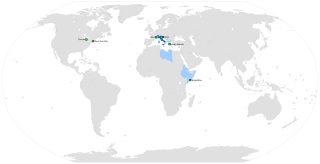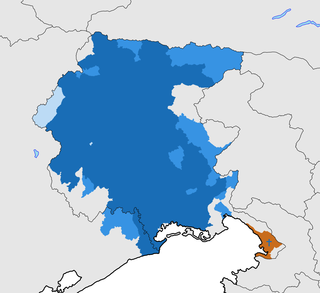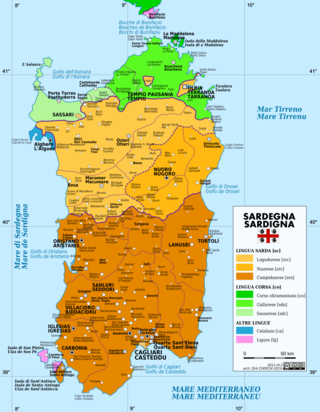
Italian is a Romance language of the Indo-European language family that evolved from the Vulgar Latin of the Roman Empire. Together with Sardinian, Italian is the least divergent language from Latin. Spoken by about 85 million people (2022), Italian is an official language in Italy, San Marino, Switzerland, and is the primary language of Vatican City. It has official minority status in Croatia and in some areas of Slovenian Istria.

The Romance languages, also known as the Latin or Neo-Latin languages, are languages that are directly descended from Vulgar Latin. They are the only extant subgroup of the Italic branch of the Indo-European language family.

The Gallo-Romance branch of the Romance languages includes in the narrowest sense the langues d'oïl and Franco-Provençal. However, other definitions are far broader and variously encompass the Occitan or Occitano-Romance, Gallo-Italic or Rhaeto-Romance languages.

Friulian or Friulan is a Romance language belonging to the Rhaeto-Romance family, spoken in the Friuli region of northeastern Italy. Friulian has around 600,000 speakers, the vast majority of whom also speak Italian. It is sometimes called Eastern Ladin since it shares the same roots as Ladin, but over the centuries, it has diverged under the influence of surrounding languages, including German, Italian, Venetian, and Slovene. Documents in Friulian are attested from the 11th century and poetry and literature date as far back as 1300. By the 20th century, there was a revival of interest in the language.
The phonology of Italian describes the sound system—the phonology and phonetics—of Standard Italian and its geographical variants.

The Gallo-Italic, Gallo-Italian, Gallo-Cisalpine or simply Cisalpine languages constitute the majority of the Romance languages of northern Italy: Piedmontese, Lombard, Emilian, Ligurian, and Romagnol. In central Italy they are spoken in the northern Marches ; in southern Italy in some language islands in Basilicata and Sicily.

Central Italy is one of the five official statistical regions of Italy used by the National Institute of Statistics (ISTAT), a first-level NUTS region, and a European Parliament constituency.
French is a Romance language that specifically is classified under the Gallo-Romance languages.
Cantabrian is a group of dialects belonging to Astur-Leonese. It is indigenous to the territories in and surrounding the Autonomous Community of Cantabria, in Northern Spain.
The Sicilian vowel system is characteristic of the dialects of Sicily, Southern Calabria, Cilento and Salento. It may alternatively be referred to as the Sicilian vocalic scheme or the Calabro-Sicilian vowel system.
As a member of the dialect continuum of Romance languages, Catalan displays linguistic features similar to those of its closest neighbors. The following features represent in some cases unique changes in the evolution of Catalan from Vulgar Latin; other features are common in other Romance-speaking areas.
In the Romance languages, metaphony was an early vowel mutation process that operated in all Romance languages to varying degrees, raising certain stressed vowels in words with a final or or a directly following. This is conceptually similar to the umlaut process characteristic of the Germanic languages. Metaphony is most extensive in the Italo-Romance languages, and applies to nearly all languages of Italy. However, it is absent from Tuscan, and hence from Standard Italian.
The dialect of Castelmezzano is a Romance variety spoken in Castelmezzano in the Province of Potenza in Italy. It constitutes a dialect of the Neapolitan language that differs from the rest in its treatment of Latin back vowels, showing an evolution more reminiscent of Balkan Romance: Latin /ŭ/ merges with /ū/ rather than with /ō/.

Sardinian is conventionally divided, mainly on phonological criteria, into three main varieties: Campidanese, Logudorese, and Nuorese. The last of these has a notably conservative phonology, compared not only to the other two varieties, but also to other Romance languages as well.
Romance linguistics is the scientific study of the Romance languages.
Proto-Romance is the comparatively reconstructed ancestor of all Romance languages. It reflects a late variety of spoken Latin prior to regional fragmentation.
This article covers the phonology of the Kerkrade dialect, a West Ripuarian language variety spoken in parts of the Kerkrade municipality in the Netherlands and Herzogenrath in Germany.
As Classical Latin developed into Proto-Romance it experienced various sound changes. An approximate summary of changes on the phonemic level is provided below. Their precise order is uncertain.

The Lausberg area is a part of southern Italy that covers much of Basilicata and the northern edge of Calabria, where Southern Italian dialects characterized by atypical Italo-Romance vowel developments are spoken. It is named after the German philologist Heinrich Lausberg, who brought the area to the attention of mainstream scholarship in 1939.
Palatalization in the Romance languages encompasses a variety of sound changes in Late Latin and in the languages descended from it that caused consonants to gain a palatal or palatalized pronunciation, generally through the influence of an adjacent consonant or vowel. This eventually resulted in the development of a series of palatal or postalveolar consonants in most Romance languages, e.g. Italian.








